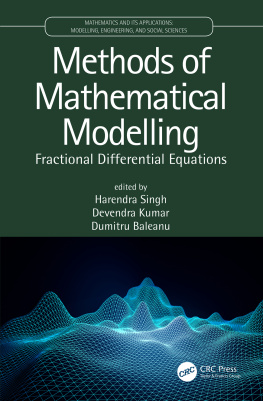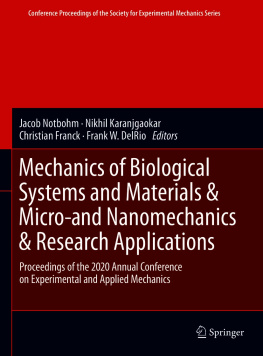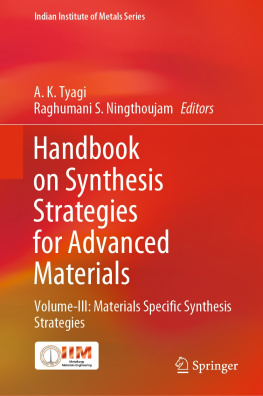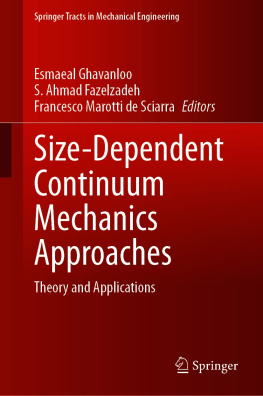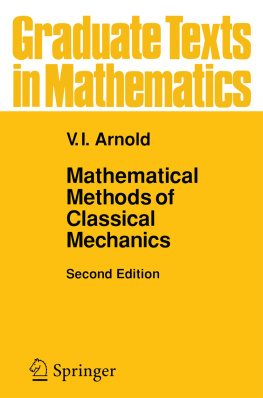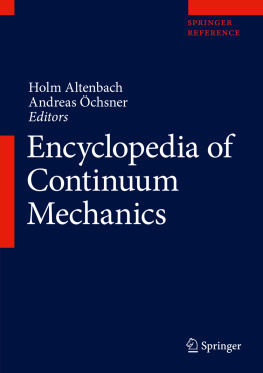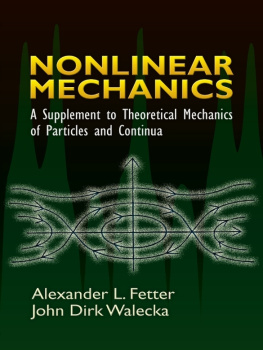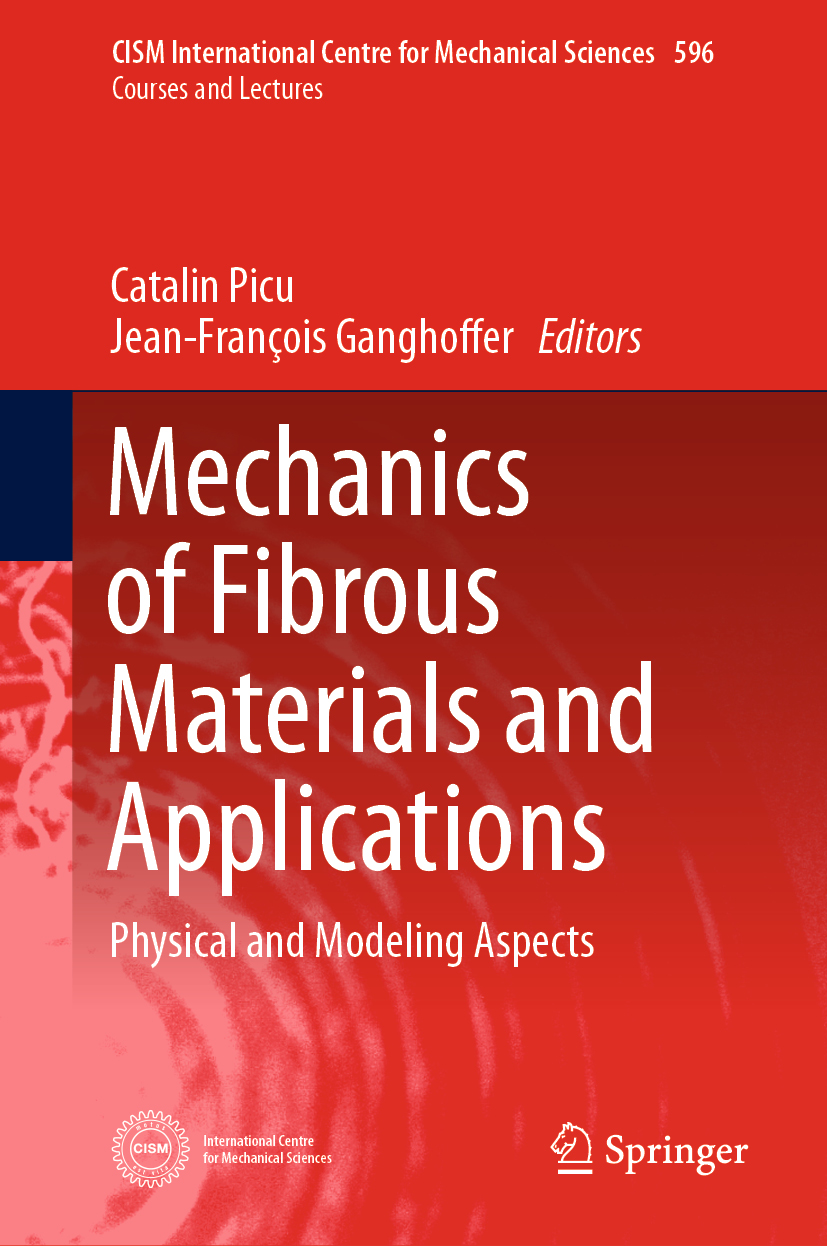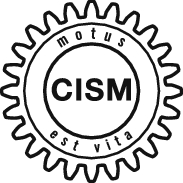Volume 596
CISM International Centre for Mechanical Sciences Courses and Lectures
Series Editors
Elisabeth Guazzelli
IUSTI UMR 7343, Aix-Marseille Universit, Marseille, France
Franz G. Rammerstorfer
Institut fr Leichtbau und Struktur-Biomechanik, TU Wien, Vienna, Wien, Austria
Wolfgang A. Wall
Institute for Computational Mechanics, Technical University Munich, Munich, Bayern, Germany
Bernhard Schrefler
CISM - International Centre for Mechanical Sciences, Udine, Italy
Managing Editor
Paolo Serafini
CISM - International Centre for Mechanical Sciences, Udine, Italy
For more than 40 years the book series edited by CISM, International Centre for Mechanical Sciences: Courses and Lectures, has presented groundbreaking developments in mechanics and computational engineering methods. It covers such fields as solid and fluid mechanics, mechanics of materials, micro- and nanomechanics, biomechanics, and mechatronics. The papers are written by international authorities in the field. The books are at graduate level but may include some introductory material.
More information about this series at http://www.springer.com/series/76
Editors
Catalin Picu and Jean-Franois Ganghoffer
Mechanics of Fibrous Materials and Applications Physical and Modeling Aspects
Editors
Catalin Picu
Department of Mechanical, Aerospace and Nuclear Engineering, Rensselaer Polytechnic Institute, Troy, MI, USA
Jean-Franois Ganghoffer
LEM3 - CNRS, Universit de Lorraine, Vanduvre-ls-Nancy, France
ISSN 0254-1971 e-ISSN 2309-3706
CISM International Centre for Mechanical Sciences
ISBN 978-3-030-23845-2 e-ISBN 978-3-030-23846-9
https://doi.org/10.1007/978-3-030-23846-9
CISM International Centre for Mechanical Sciences 2020
This work is subject to copyright. All rights are reserved by the Publisher, whether the whole or part of the material is concerned, specifically the rights of translation, reprinting, reuse of illustrations, recitation, broadcasting, reproduction on microfilms or in any other physical way, and transmission or information storage and retrieval, electronic adaptation, computer software, or by similar or dissimilar methodology now known or hereafter developed.
The use of general descriptive names, registered names, trademarks, service marks, etc. in this publication does not imply, even in the absence of a specific statement, that such names are exempt from the relevant protective laws and regulations and therefore free for general use.
The publisher, the authors and the editors are safe to assume that the advice and information in this book are believed to be true and accurate at the date of publication. Neither the publisher nor the authors or the editors give a warranty, expressed or implied, with respect to the material contained herein or for any errors or omissions that may have been made. The publisher remains neutral with regard to jurisdictional claims in published maps and institutional affiliations.
This Springer imprint is published by the registered company Springer Nature Switzerland AG
The registered company address is: Gewerbestrasse 11, 6330 Cham, Switzerland
Preface
Materials containing fibers are present in a large variety of applications due to their high mechanical performances at low weight. Reinforcement of continua with fibers has a long history which led to the widely used class of fiber-reinforced composites. Examples include polymers reinforced with fiberglass, high-performance composites made from woven yarns, and 3D woven composites used in cutting-edge areas such as aeronautics.
Different classes of fibrous materials are those containing a crosslinked network of fibers, which may or may not be embedded in a matrix. A prominent example is nonwovens, which are used in many applications such as sound and thermal insulation, clothing, filtration, and geotextiles. Many biological materials have a random complex fibrous structure. Examples include soft connective tissue, such as tendons and ligaments, the arterial walls, and the cellular cytoskeleton. Damage accumulation, fracture, and the related nonlinear behavior under large deformations are important considerations in all these materials.
Due to their discrete architecture, fibrous media have a rather complex mechanical response, especially since multiscale aspects are essential in such structures. Individual fibers or filaments may be assembled in multiscale architectures, from fibers to complex yarns up to woven or braided structures. Their geometrical configuration, which results from the manufacturing method used and the geometry of the fibers, are not easy to capture and characterize. Moreover, they exhibit strong geometrical and material nonlinearities due to the collective motion of the fibers, fiber bundles or yarns, associated nonlinear interactions that include friction and adhesion, and the presence of large local and global deformations with evolving anisotropy and couplings between different deformation modes.
This book brings together lecture notes organized for the CISM course titled Mechanics of Fibrous Materials and Applications: Physical and Modelling Aspects , held in Udine from July 9 to July 13, 2018. The course objective was to present the state-of-the-art understanding in this area and to provide an overview of the theoretical, modeling and practical aspects of designing and working with fibrous materials. Six lecturers contributed to the course: Philippe Boisse (INSA Lyon, France), Jean-Francois Ganghoffer (Universite de Lorraine, France), Edoardo Mazza (ETH Zurich, Switzerland), Mohammad Mofrad (Berkeley University, USA), Catalin Picu (Rensselaer Polytechnic Institute, USA), and Luca Placidi (Universita Uninettuno, Italy). This book summarizes this information through the perspective of four of these six lecturers, and their collaborators.
Chapter by Catalin Picu, titled Mechanics of Random Fiber Networks: StructureProperties Relation, discusses aspects of the mechanical behavior of fibrous materials containing a random network of fibers. The focus is on identifying the network parameters that control the mechanics of the structure. Such random networks are encountered in biological tissues, scaffolds for tissue growth, and many engineering materials. The chapter presents a classification of networks based on their architecture, the type of fibers, and the essential interactions that define their overall mechanical behavior. Further, it presents key results for the linear and nonlinear response of networks subjected to tension and compression, including relations between various parameters of the network and the described mechanical behavior. A similar analysis is presented for the strength of networks and its dependence on network parameters. A separate subsection is devoted to crosslinked and non-crosslinked networks in which fibers interact adhesively. In this case, adhesion reorganizes the network and imparts a particular mechanical behavior to the ensemble.



